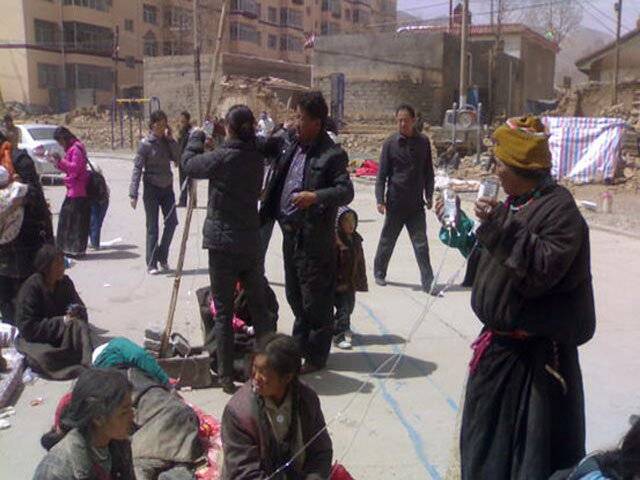A series of strong earthquakes struck Chinas western Qinghai province Wednesday, killing at least 300 people, injuring thousands and burying many others under toppled houses in a mountainous rural area, officials and state media said. The U.S. Geological Survey said a magnitude 6.9 temblor struck an area in southern Qinghai, near Tibet, on Wednesday morning and was followed by several aftershocks. The main quake sent residents fleeing as it toppled houses made of mud and wood, said Karsum Nyima, the Yushu county television stations deputy head of news, speaking by phone with broadcaster CCTV. In a flash, the houses went down. It was a terrible earthquake, he said. In a small park, there is a Buddhist tower and the top of the tower fell off. ... Everybody is out on the streets, standing in front of their houses, trying to find their family members. The quake hit the county of Yushu, a Tibetan area in Qinghais south, said the China Earthquake Networks Center, which measured the quakes magnitude at 7.1. A local government Web site put the countys population in 2005 at 89,300, a community of mostly herders and farmers. State broadcaster CCTV said the death toll had risen to about 300, with an additional 8,000 people injured. The China Earthquake Administration said phone lines were down, hindering rescue efforts, while workers were racing to release water from a reservoir where a crack had formed after the quake. In Jiegu, a township near the epicenter, more than 85 percent of houses had collapsed, while large cracks have appeared on buildings still standing, the official Xinhua News Agency cited Zhuohuaxia, a local publicity official, as saying. The streets in Jiegu are thronged with panic and full of injured people, with many of them bleeding from their injuries, he said. There were also students buried under the debris of a collapsed vocational school, Zhuohuaxia said. State television showed footage of paramilitary police using shovels to dig around a house with a collapsed wooden roof. A local military official, Shi Huajie, told state broadcaster CCTV rescuers were working with limited equipment. The difficulty we face is that we dont have any excavators. Many of the people have been buried and our soldiers are trying to pull them out with human labor, Shi said. It is very difficult to save people with our bare hands. Five thousand tents and 100,000 thick, cotton coats and heavy blankets were being sent to help survivors cope with strong winds and nearfreezing temperatures of around 43 degrees Fahrenheit (6 degrees C), the Qinghai provincial government said in a statement. Wu Yong, a local military chief, said medical workers also were urgently needed but that roads leading to the airport had been badly damaged by the quake, creating difficulties for people and supplies to be flown in. He said rescue efforts were hindered by frequent aftershocks and strong winds. The epicenter of the first quake was located 235 miles (380 kilometers) southsoutheast of Golmud, a large city in Qinghai, at a depth of six miles (10 kilometers), the USGS said. Ten minutes later, the area was hit by a magnitude 5.3 quake, which was followed after two minutes by a temblor measuring 5.2, according to the U.S. agency. Both the subsequent earthquakes were measured at a depth of 6 miles (10 kilometers). Another quake, measuring 5.8, was recorded at 9:25 a.m. Xinhua cited officials at the China Earthquake Networks Center as saying at least 18 aftershocks have been reported and that more temblors exceeding magnitude 6 were likely to occur in the coming days. In 2008, a magnitude7.9 quake in Sichuan province left almost 90,000 people dead or missing.
Friday, April 19, 2024
Strong quake in western Chinas Qinghai kills 300

SC suspends ECP’s re-polling order in PP-51
April 19, 2024
Court approves plea bargain of Parvez Elahi’s co-accused
April 19, 2024
Zardari creates another parliamentary record
April 19, 2024
KP politicians, civil society laud President’s address
April 19, 2024
A Tense Neighbourhood
April 19, 2024
Dubai Underwater
April 19, 2024
X Debate Continues
April 19, 2024
Hepatitis Challenge
April 18, 2024
IMF Predictions
April 18, 2024
Kite tragedy
April 19, 2024
Discipline dilemma
April 19, 2024
Urgent plea
April 19, 2024
Justice denied
April 18, 2024
AI dilemmas unveiled
April 18, 2024
ePaper - Nawaiwaqt
Advertisement
Nawaiwaqt Group | Copyright © 2024





